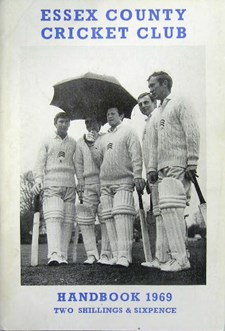
Sunshine and Showers
* * *
To raise their spirits after a hard working week, cricketers need sunshine and blue skies to enjoy the game to the full. Today, pitch and ground covers can be seen on most club grounds around Essex, and they have helped to ensure that matches are played that would otherwise have been lost to the cricketer's age-old enemy - rain.
Until the 18th century, matches weren’t disturbed by rain as much as they are today. Bowlers didn’t have problems with their run-ups when bowling underarm and the pitches weren’t as hard and compact until the rolling of pitches became common in the late 19th century. Once started, matches tended to be completed - mainly because the huge numbers of wagers by spectators and players meant that a result was demanded! Disputes often arose as to whether or not a match should continue in bad weather.
Much of Essex's 1,500 square miles is predominantly low-lying (the highest point is 147m at Chrishall Common, near Langley) and can best be described as rolling countryside dissected by many river valleys. Fortunately for cricket lovers, it is the third driest county in England (a squeak behind Cambridgeshire and Huntingdonshire), with an average rainfall of 581 mm per annum over the past 30 years. Of course, the West of the county receives more rain than the East where the lucky members of the Great Wakering Cricket Club (founded in 1930) enjoy their cricket in the county’s driest location.
With the longest coastline of any English county, Essex has experienced an average of over 1,600 hours of sunshine per annum (the sixth highest in England) over the past 30 years. And as it is usually blessed with the highest July average temperature of all the English counties, Essex club cricketers are likely to play more days of cricket during the season than their counterparts in most other counties.
The coldest night on record in Essex occurred in South Ockendon on February 8th, 1879 when minus 21 degrees celcius was registered. The record wind gust in Essex occurred at Shoeburyness during 'The Great Storm' in 1987 - at 101 mph.
Despite Essex’s good fortune to enjoy agreeable summer climes, it still gets its share of erratic fluctuations of temperature. Sudden changes in weather conditions in the county are not a recent phenomenon as our TV weather experts might lead us to believe. On 2nd June 1975, at Castle Park, Colchester (where county cricket was first played on 18th June 1914 against Worcester), the match against Kent was temporarily halted due to snow! However, it didn’t deter Graham Gooch - he scored precisely 100 and Essex won by 33 runs. But just a few days later, on 12th June against Nottinghamshire at Valentine’s Park, Ilford, temperatures climbed to 26°C.

1969 - a miserable year for weather in Essex
Another match in which Essex CCC experienced harsh weather conditions was in April 1981 during the traditional pre-season, ‘warm-up’ match against Cambridge University at F. P. Fenner’s ground. Scarves and bobble hats were worn by the Essex fielders in bitterly cold weather and play had to be suspended by the umpires (Don Oslear and Nigel Plews) - the decision taken only after spinner and joker Ray East had borrowed and donned an overcoat from the scoreboard operator to stress the point!
In February 1834, the future Prime Minister, Benjamin Disraeli, who was staying at Porters Grange in Southend-on-Sea, wrote to his sister saying, ‘You couldn't find a softer climate and sunnier skies than at Southend-on-Sea’. And Don Bradman’s Australians clearly enjoyed the fine weather and bright seaside sunshine - they hammered 721 runs in a day against Essex CCC at Southchurch Park, Southend on 15th May 1948 - phew!

North Stifford Village Green - Belhus CC remembers the wet 2012 season
The 2012 season was the wettest since weather records began - no less than 53 of our senior matches were either cancelled or abandoned. That miserable season will never be forgotten - it resulted in a dramatic fall in bar revenues and a considerable loss of match fees.
* * *
Denis Reed 2017